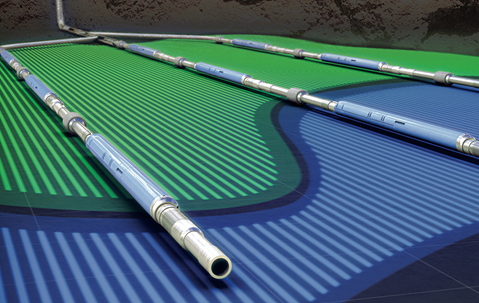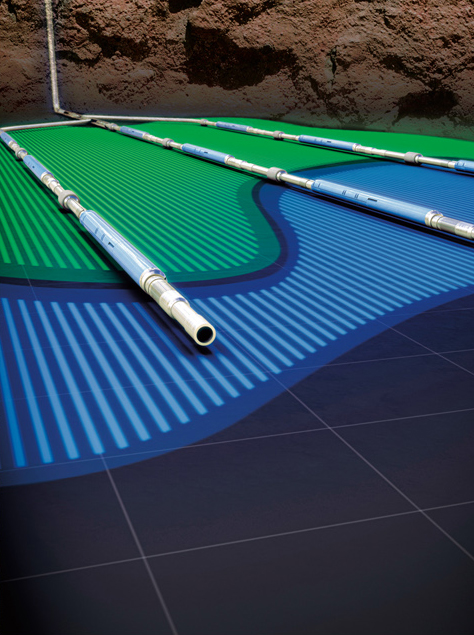Schlumberger believes that the most effective response to these challenges is to create a step change in the way the industry finds, develops, and produces hydrocarbons. As the leading global oilfield services company, our investment in technology has helped our customers gain access to new reserves, increase reservoir recovery and production, and maximize their returns. Moving forward, we see significant opportunities in changing the way we work to respond to the immediate business challenges our customers face and to lay the foundation for a distinct and sustainable competitive advantage.
For nearly 90 years, a focus on the science of measurement has established Schlumberger as the leading technology provider for the oil and gas services industry. Our customers depend upon us to acquire data and maximize its use to achieve their exploration and production goals and reduce subsurface risk. An integral part of this focus has always been the conviction that achieving success means there is still room for improvement.
This is why in 2007, during a period of healthy market growth, we challenged ourselves by asking how we could improve upon what we do and the way we do it. Ultimately, this challenge established new ways of working that focus on technology innovation and increasing reliability, efficiency, and integration. Changing our way of working throughout the company meant that every process, system, and behavior had to be placed under the magnifying glass for objective assessment.
We began our transformation journey in late 2007 by analyzing the process of new technology development in our Research and Engineering organization. By 2014, a $350 million investment in the transformation established the Engineering, Manufacturing, and Sustaining organization as well as the Schlumberger Product Development Method, which is now used throughout the company. In addition, subsequent growth in 2010 due to the Smith International and Geoservices acquisitions precipitated the creation of a Shared Services Organization in 2011 to streamline internal processes and establish regional centers to improve field operations support.
When oil prices began to decline in 2014, we were already seven years into our transformation journey. Schlumberger and its customers are now realizing even greater benefits through our transformation, such as improved product reliability through better engineering design and maintenance, and increased process reliability via a fully upgraded management system, leading to increased operational performance. On the basis of our experience thus far, we decided to accelerate the transformation program by introducing new phases into existing themes.
Transformation as a pathway to growth is driven by our key themes of technology innovation, reliability, efficiency, and integration. While the transformation journey has much to show from our efforts, some of which is presented here, there is still much we plan to accomplish.

In 2007, Schlumberger took a critical look at the complex process of developing new technology. From invention to design, manufacturing, and a product’s total lifecycle, objective analysis by multidisciplinary teams found that while we did some things well, there were distinct areas for improvement. The three key areas included increasing the rate of technology innovation, reducing the time to market, and improving product reliability and performance.
read moreSchlumberger has grown considerably during the last five years as a result of the Smith International and Geoservices acquisitions in 2010. With the broadest technology portfolio in the industry, it was clear to us that the lessons learned during our transformation of Research and Engineering could be applied to the entire organization. The next logical step on our transformation journey was to create a Shared Services Organization (SSO) for our support functions that leveraged our size to enable profitable growth and manage business cycles more efficiently.
read moreAs we continue on our transformation journey to improve technology, reliability, efficiency, and integration, we have moved into a new phase that includes their accelerated deployment and expanding engagement throughout the company as we evolve toward new ways of working.
read moreThe Schlumberger transformation program has four main themes—technology, reliability, efficiency, and integration—and the examples presented thus far have touched on each one. Further developing these themes enterprise-wide is inherently complex due to our large footprint: more than 95,000 people, approximately 85 countries, 150,000 mobile assets, and 2,250 facilities. However, leveraging the transformation across the enterprise will enable us to fully capitalize on our size so that we will continue to outperform the market in the long term.
read more
The three stations shown of the Manara production and reservoir management system control the production characteristics of an individual zone. Produced fluids, noted with green for oil and blue for water, flow through a screen to the station where pressure, temperature, flow rate, and water cut are measured.
Saudi Aramco had a vision and commitment to develop technology that would take hydrocarbon recovery to a new level. Named after the Arabic word for lighthouse, the Manara system is the result of an eight-year collaboration between Saudi Aramco and Schlumberger.
The Manara production and reservoir management system is an intelligent completion system for multizone, multilateral, extended-reach, and Extreme Reservoir Contact wells. Combining 30 patented technologies, the Manara system provides permanent downhole pressure, temperature, water cut, and flow rate monitoring as well as in-lateral flow control of zones in real time.
The information derived from a conventional completion system typically permits engineers to make production decisions in days or weeks. The Manara system’s real-time permanent monitoring reduces the decision-making time to hours. This means reservoir workflows that commonly required three to six months can now be performed in one day. Integrated workflows from multiple disciplines create a collaborative work environment, where the identification and correction of problems in individual zones are made in real time. Rig time is reduced by optimizing a zone-by-zone cleanup procedure that also minimizes health, safety, and environmental risks.
The Manara system uses fewer parts than a conventional completion system. Electric power and downhole data pass through an inductive coupler that can service any number of well junctions. One electric control line connects through the wellbore to the wellhead via a single penetration.
Saudi Aramco’s Dhahran Advanced Research Center coordinated user requirements and, in conjunction with Schlumberger Engineering, developed a qualification testing program to de-risk the enabling technologies in the Manara system. This included extensive field testing in multiple Saudi Aramco wells. The Schlumberger focus on the transformation themes of technology, reliability, efficiency, and integration was important for the successful collaboration with Saudi Aramco.